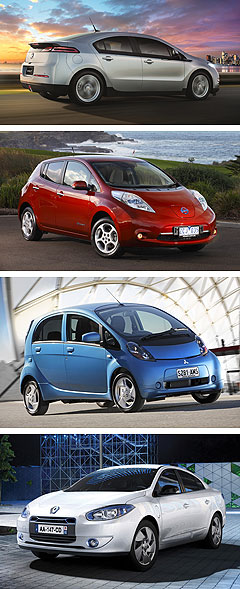News - Market InsightEV battery costs set to plunge: reportPack horses: A dramatic decline in lithium-ion battery costs will be just one factor in sparking widespread acceptance of EVs in Australia. Global EV boom in focus as study predicts huge drop in lithium-ion battery costs17 Aug 2012 By TERRY MARTIN STRONGER demand for electrified vehicles and their broad acceptance worldwide is expected to come as battery costs reduce, making EVs and plug-in hybrids more affordable and competitive with cars using an internal combustion engine (ICE). How quickly and deeply this may occur is still the subject of speculation in the industry, although a recent McKinsey study found that the price of automotive lithium-ion batteries was expected to fall dramatically by 2020, and even further by the middle of next decade. In developing a “should cost” model that estimates how the price of a “complete automotive lithium-ion battery pack” could evolve through to 2025, the McKinsey researchers found that the price could fall from $US500 to $US600 per kilowatt hour (kWh) today to about $200 per kWh by 2020 and around $160 per kWh by 2025. The authors also say that, with petrol prices at or above $US3.50 a gallon in the US, car-makers could be in a position to offer electric vehicles competitively against vehicles powered by advanced ICEs, on a five-year total-cost-of-ownership basis, as soon as the battery pack price hits $US250 per kWh. Based on these assumptions, that could see the battery cost of the Chevrolet/Holden Volt plug-in hybrid in the US reduce from about $US8000 today to $US2500 by 2025.  From top: Holden Volt Nissan Leaf Mitsubishi i-MiEV Renault Fluence ZE. From top: Holden Volt Nissan Leaf Mitsubishi i-MiEV Renault Fluence ZE.The report suggests that three factors will accelerate the day when electrified vehicles become “more compelling alternatives” to combustion-engine cars: manufacturing at scale, lower components prices, and battery capacity-boosting technologies. According to the researchers, about a third of the potential price reductions through to 2025 could be achieved within only three years through improvements in manufacturing processes, standardising equipment and spreading fixed costs over higher unit volumes. A reduction in materials and parts prices could represent about 25 per cent of savings, and could be largely achieved by 2020, based primarily on component manufacturers boosting their productivity and “moving operations to locations where costs are optimal”. The report also says that technical advances in cathodes, anodes and electrolytes could increase the capacity of batteries by 80 to 110 per cent by 2020-25, which represent 40 to 45 per cent of the indentified price reductions. Official VFACTS figures show 63 new electric vehicles were registered in Australia in the first seven months of this year, comprising 51 Nissan Leafs (officially on sale since June) and 12 examples of the Mitsubishi i-MiEV. This will increase as new models such as the forthcoming Holden Volt and Renault Fluence ZE – to name just two fast-approaching vehicles – are released, although issues such as the absence of government subsidies, the need to build a national recharging infrastructure and the generally cautious approach by car-makers will ensure the take-up rate here is slow. In the US, figures from the Electric Drive Transportation Association show that 5153 EVs were sold to the end of July, as well as 15,700 plug-in hybrids (including range-extender vehicles), a large proportion of which are Chevrolet Volts. Last year, Americans bought 7671 plug-in hybrids and just over 10,000 EVs – compared to 266,329 conventional hybrids – while Australian figures show 49 EVs and 8820 hybrids (none of which are plug-in versions). Of course, the rate of adoption will vary across different markets, with a range of key factors other than battery prices having an influence. The McKinsey researchers highlight economic and regulatory conditions, the performance and reliability of electrified vehicles, and customer preferences as being important considerations. Different strategies, product development cycles and levels of investment among the car-makers could also serve to vary the rate of battery price reductions by three to five years, according to the report. Car-makers’ views on how other powertrain technologies will mature – from the ICE through to conventional hybrids and plug-in variants – and their own projections of petrol price movements will also influence the rate at which battery prices decline. And there are other limiting factors. Experts commenting on the McKinsey study have pointed to the rechargeable capacity loss inherent in lithium-ion batteries, which can reportedly lose up to 20 per cent capacity within 12 months in certain climates and reduce battery life to only three or four years. Others have noted how tough it is for start-up automotive lithium-ion battery producers to survive and the massive investments required, and that major cost savings might only be realised by global car-makers that are in a position to purchase large quantities of battery packs. There are clearly many variables, but the world’s biggest car companies – and many smaller ones around them – clearly have electrification as a core part of their product development strategies, which will push the ongoing development of the lithium-ion sector and bring prices down. This is bound to have a massive influence on EV sales around the world, even in a country like ours bound by its tyranny of distance.  Read more19th of June 2012  Next Nissan Leaf to be braverSecond-generation Nissan Leaf EV set to move away from conventional design3rd of April 2012  Renault tests Zoe EV in OzLow-cost Zoe EV tests in Australia as Renault looks forward to local release23rd of March 2012  Renault refutes EV fearsEducation vital to break down EV fears and convert buyers, says local Renault boss12th of December 2011  Next-generation Volt to be cheaperGM targets better range, efficiency and price for next Volt due around 201625th of October 2011  Getting closer to a Better PlaceCanberra trial for electric vehicle infrastructure is on target for 2012 roll-out |
Click to shareMarket Insight articlesResearch Market Insight Motor industry news |
















Facebook Twitter Instagram